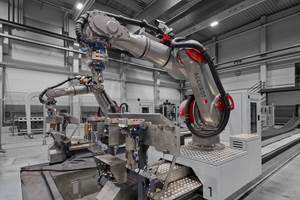Toray wins carbon fiber supply contract for Boeing 777X composite wings
Tokyo-based Toray, the world's largest manufacturer of carbon fiber, will expand its current contract for the Boeing 787 Dreamliner to include the 777X composite wings.
The Boeing Co. (Everett, Wash., USA) reported on Nov. 16 that it has signed a memorandum of agreement with carbon fiber manufacturer Toray Industries (Tokyo, Japan) to expand its current contract for the Boeing 787 Dreamliner to include the 777X wings. Once finalized, the long-term contract extension will take effect in 2015 and meet Boeing's customer affordability goals through the Partnering for Success program.
The addition of the 777X to the current 787 contract represents a significant increase in the material provided to Boeing by Toray. Boeing and Toray will also collaborate to improve commercialization of composite materials in the aerospace market. Specific areas the companies will address include increased consistency and performance of composite materials across the production system and a cost structure that is more competitive with metals.
"This partnership is a great example of why Toray is the market leader in composite materials," says John Tracy, Boeing chief technology officer and senior vice president for Engineering, Operations & Technology. "Their understanding of the technology is outstanding, but they also know there is much more we can do with composites in aerospace if we work together to improve the performance, processing and economics. Toray is working with us on that and we are happy to expand their work statement to include the 777X."
Boeing and Toray pioneered the use of prepreg composites in the 1970s. By 1994, assemblies including the empennage and floor beams were being produced for the 777 program, the first commercial airplane featuring structurally significant composite parts. That early success culminated in the launch of the 787 in 2004, the world's first largely composite commercial airplane.
"We believe that this agreement signifies the solid mutual trust Toray has been building with Boeing through the stable supply of high quality carbon fiber materials since the 1970s," says Akihiro Nikkaku, president, Toray Industries. "It also reflects Boeing's recognition of our world-class technology and firm commitments to expanding composites application to aircraft. Going forward, Toray will continue to duly enhance its supply capacity in line with the production increases planned by Boeing."
"Boeing has partnered with the Japanese aerospace industry for nearly five decades," says George Maffeo, president, Boeing Japan. "Their work encompasses the development and introduction of all current Boeing programs: the Next-Generation 737, 737 MAX, 747, 767, 777 and 787 Dreamliner. The consistent performance of our Japanese partners and their enduring effort and dedication, as exemplified today by Toray, has helped Boeing achieve tremendous success with our products. We couldn't be more delighted to continue that legacy with the 777X."
With this agreement, Boeing will have contracts in place for more than 75 percent of the major structural material for the 777X. The wingspan of the 777X measures 71.7m/235.4 ft, 6.95m/22.8 ft longer than the span of today's 777-300ER. Its raked wingtip and optimized span are designed to deliver greater efficiency and significant fuel savings while being compatible with today's airport gates. The 777X wings will be manufactured at Boeing's Everett, Wash., site.
In 2013, Boeing spent more than $4 billion on goods and services in Japan. Including this agreement for the 777X composite wing, Boeing expects to purchase an additional $36 billion of goods and services locally by the end of the decade, supporting tens of thousands of aerospace jobs.
Related Content
Otto Aviation launches Phantom 3500 business jet with all-composite airframe from Leonardo
Promising 60% less fuel burn and 90% less emissions using SAF, the super-laminar flow design with windowless fuselage will be built using RTM in Florida facility with certification slated for 2030.
Read MoreAutomated robotic NDT enhances capabilities for composites
Kineco Kaman Composites India uses a bespoke Fill Accubot ultrasonic testing system to boost inspection efficiency and productivity.
Read MoreMFFD longitudinal seams welded, world's largest CFRTP fuselage successfully completed
Fraunhofer IFAM and partners have completed left and right welds connecting the upper and lower fuselage halves and sent the 8×4-meter full-scale section to ZAL for integration with a cabin crown module and testing.
Read MorePlant tour: Collins Aerospace, Riverside, Calif., U.S. and Almere, Netherlands
Composite Tier 1’s long history, acquisition of stamped parts pioneer Dutch Thermoplastic Components, advances roadmap for growth in thermoplastic composite parts.
Read MoreRead Next
Cutting 100 pounds, certification time for the X-59 nose cone
Swift Engineering used HyperX software to remove 100 pounds from 38-foot graphite/epoxy cored nose cone for X-59 supersonic aircraft.
Read MoreUltrasonic welding for in-space manufacturing of CFRTP
Agile Ultrasonics and NASA trial robotic-compatible carbon fiber-reinforced thermoplastic ultrasonic welding technology for space structures.
Read MoreNext-gen fan blades: Hybrid twin RTM, printed sensors, laser shock disassembly
MORPHO project demonstrates blade with 20% faster RTM cure cycle, uses AI-based monitoring for improved maintenance/life cycle management and proves laser shock disassembly for recycling.
Read More

























